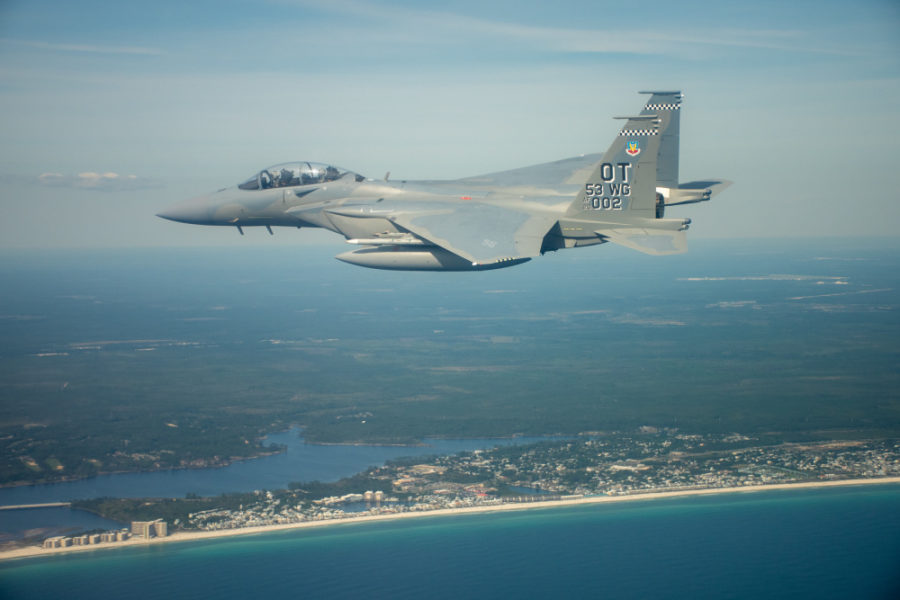F-15EX is the most advanced Eagle variant based on the F-15QA as a replacement for the legacy F-15C/D. The Eagle II is the first USAF F-15 to boast digital fly-by-wire flight controls, LAD glass-cockpit with touch-screen interface, and incorporate APG-82 AESA radar, Joint Helmet Mounted Cueing System (JHMCS), and EPAWSS self-defensive suite from the outset.
The aircraft pioneers Open Mission System (OMS) software to enable rapid upgrades and capability enhancement, as well as the latest Suite 9.1 software in common with upgraded legacy aircraft.
F-15EX promises higher speed, longer range, increased 29,500 lb payload (including two additional weapon stations), and lower operating costs than previous variants. The type also boasts the longest stand-off air-to-air engagement range of any fighter in the USAF inventory.
Due to insufficient F-22 procurement, the F-15C/D fleet has continued flying beyond its designed service life, posing a serious risk of structural failure.
USAF awarded Boeing a $1.2 billion contract for the first eight jets in July 2020 and approved the jet for full-rate production in June 2024 , accelerating funds to speed phase-out of the F-15C/D. USAF requested funding for 18 aircraft in FY25 and Congress provided for an additional six requested by the ANG.
The first-of-six test aircraft was delivered to Eglin on March 11, 2021, and the F-15EX completed combined developmental and operational testing in August 2023. The aircraft proved operationally effective in all intended roles of air superiority and offensive and defensive counter-air, including against simulated fifth-generation threats. F-15EX was also deemed effective in a limited air-to-ground role, but test limitations inhibited full evaluation of EW capabilities.
Development is focused on fielding full capabilities on early Lot aircraft including Mobile User Objective System (MUOS) secure, jam-resistant BLOS and NATO-interoperable LOS SATURN and GPS, as well as adding Automatic Ground Collision Avoidance System (AGCAS).
The service originally planned to purchase 144 aircraft before reducing its buy to 104 and again to 98 in its FY25 request. The F-15EX achieved IOC a year later than initially planned following delivery of the second operational jet to the Oregon ANG at Portland on July 5, 2024. Similar aircraft requirements permit existing F-15 units to transition to the F-15EX in a matter of months and USAF plans to field the 44-jet fleet required for full operational capability (FOC) by 2027.
Follow-On Operational Testing and Evaluation (FOT&E) will evaluate the aircraft against emerging and more capable fifth-generation threats in complex scenarios. The F-15EX will replace legacy F-15s at Fresno and New Orleans as well as backfilling Kadena. Barnes will receive either F-15EX or F-35 pending the results of an environmental review.
F-15EX Eagle II Technical Data
Contractors: Boeing; BAE Systems (EPAWSS); Raytheon (AESA).
First Flight: Feb. 2, 2021.
Delivered: Mar. 11, 2021-present.
IOC: July 2023 (originally planned).
Production: 104 (planned)
Inventory: Eight.
Operator: ACC, AFMC. Planned: ANG.
Aircraft Location: Eglin AFB, Fla. Planned: Fresno ANGB, Calif.; Kadena AB, Japan; Klamath Falls (Kingsley Field); NAS JRB New Orleans, La.; and Portland Arpt., Ore.
Active Variant: •F-15EX. Future F-15C/D replacement based on the F-15QA developed for Qatar.
Dimensions: Span 42.8 ft, length 63.8 ft, height 18.5 ft.
Weight: Max T-O 81,000 lb.
Power Plant: Two General Electric F100-PW-229 turbofans with afterburners, each 29,000 lb thrust.
Performance: Speed Mach 2.5, range approx. 2,762 miles (air refuelable).
Ceiling: 60,000 ft.
Armament: One internally mounted M61A1 20 mm six-barrel cannon (500 rd); combination of up to 12 AIM-9 Sidewinders or AIM-120 AMRAAMs, or combination of up to 24 air-to-ground munitions.
Accommodation: Pilot and (optional) second aircrew member on ACES 5 zero/zero ejection seats.


